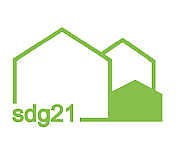Publisher: German Federal Foundation for the Environment / Sabine Djahanschah
 The ecological model settlement "Prince Eugene Park"on a former barracks site in Munich sets new standards in timber construction. Various timber construction methods and building types up to seven storeys are being tested side by side in eight building projects with the aim of a final scientific evaluation. Timber frame, timber frame and timber hybrid construction methods are being used.
The ecological model settlement "Prince Eugene Park"on a former barracks site in Munich sets new standards in timber construction. Various timber construction methods and building types up to seven storeys are being tested side by side in eight building projects with the aim of a final scientific evaluation. Timber frame, timber frame and timber hybrid construction methods are being used.
Close cooperation with the Deutsche Bundesstiftung Umwelt (DBU) and research commissions from the Ruhr Universität Bochum (RUB) and the Technische Universität München (TUM) ensure a sound evaluation of the monitoring accompanying construction. Beyond the realization of living space, the project makes an active contribution to climate protection and sustainable urban development.
Embedded in the surrounding parkland, the new quarter will also offer an attractive range of social, cultural and commercial infrastructure. Building volume 4 presents the eight building types and examines the potential of the different construction methods in detail.
Authors: Zeno Dietrich, Sabine Djahanschah, Annette Hafner, Wolfgang Huß, Ulrike Klar, Wolf Opitsch, Arnim Seidel and Michael Storck
First edition: 2020
Format: 112 Pages, German, 21 x 27 cm, Swiss brochure
Publisher: Detail Business Information GmbH, Munich
Information and photos of Europe's largest wooden building settlement:
http://sdg21.eu/db/oekologische-siedlung-im-prinz-eugen-park
Reading sample and ordering option from the publisher:
https://shop.detail.de/de_de/dbu-bauband-4-wohnquartier-in-holz
Keywords: Building materials / Construction, DE-News, Research, Wood construction, Barracks conversion, Climate protection, Communities, NaWaRohs, New books and studies, News Blog Bavaria, Settlements, Housing, Residential, Housing projects, Life cycle assessment




